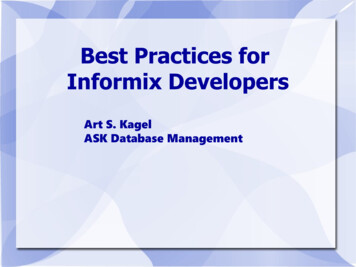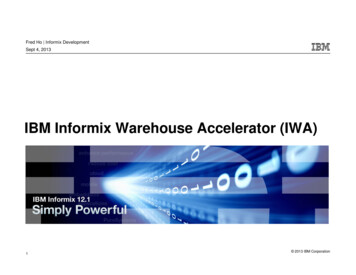
Transcription
Best Practices forInformix DevelopersArt S. KagelASK Database Management
Best Practices for Informix DevelopersAbstract:We will explore the various ways to skin the development cat,examining several typical application module scenarios. Alongthe way, we will look at how to develop better applications thatencounter fewer processing bottlenecks and take bestadvantage of IDS's features.2
Best Practices for Informix DevelopersApplication Development LanguagesApplication PerformanceNew Informix & Informix-Related Features3
Best Practices for Informix DevelopersApplication Development LanguagesIBM Development Language Support:Informix C Software Development Kit (CSDK)Current release CSDK 4.10.xC4Embedded SQL in COBOL (ESQL/COBOL)Latest Version: 7.25.xD4IBM Universal Driver for JDBC & .NETEnterprise Generation Language (EGL)Informix Compiled 4GL (Current: 7.51)Informix 4GL Rapid Development SystemInformix SQL (Current: 7.51)4
Best Practices for Informix DevelopersApplication Development LanguagesIBM Development Language Support:Informix C Software Development Kit (CSDK) features:ESQL/C compiler driver and librariesCLI / ODBC libraryOLE DB InterfaceInformix JDBC DriverInformix .NET ProviderObject Interface for C (No longer supported)5
Best Practices for Informix DevelopersApplication Development LanguagesIBM Development Language Support:Informix SQL (ISQL) featuresPerform Forms ManagerSimple data display and maintenance formsACE Report WriterText report generator using a forms-like interfaceSQL Menu ManagerMenus to tie multiple ACE and Perform modules andother application modules together into simpleapplications6
Best Practices for Informix DevelopersApplication Development LanguagesIBM Development Language Support:Informix 4GL featuresNative code and p-machine based compiler optionsLatest release integrates to WEB/SOAP (7.50 )High level 4th Generation Language with embeddedSQLEvent driven forms control modulesEvent driven report control modules7
Best Practices for Informix DevelopersApplication Development LanguagesThird Party Informix 4GL Language Support:Three vendors support extended x4GL language:Four JsQuerixAubit 4GL – Open Source8
Best Practices for Informix DevelopersApplication Development LanguagesThird Party Informix 4GL Language Support:4Js GeneroGUI - Fully graphical XML based display systemWindows, Mac OS/X, LinuxFull WEB IntegrationAjax, HTML5Web services/components, SOAMobile ClientLanguage extensions (including embedded Java)Virtual Machine/Byte code compilerDeploy single executable on any platformSupports all major RDBMS servers (but no SQL dialect mapping)Graphical report writer (proprietary)Graphical IDE tailored to 4GL language (Proprietary - Eclipse-like)4GL Code Generator Option9
Best Practices for Informix DevelopersApplication Development LanguagesThird Party Informix 4GL Language Support:QuerixLycia II Development Workbench (Eclipse based IDE)Lycia WindowBuilder - New graphical form designerOther productivity plugins: CVS, BIRT, Jasper, etc.ESQL/C Compiler included for x4GL/ESQL-C integrationSupport for most RDBMS serversDynamic SQL dialect conversionWEB, JAVA, SOAP, REST, ADO/.NET, SAX integrationBIRT & Jasper report writers integratedLanguage extensions including full Genero extension importGraphical Thin ClientsDesktopWebMobileCreate WEB services from any 4GL function10
Best Practices for Informix DevelopersApplication Development LanguagesThird Party Informix 4GL Language Support:Aubit4GLSupport for most RDBMS serversNear complete 4GL source compatibilityCharacter, XML, GUI User InterfacesPDF report output extensionLanguage extensionsEmbedded/inline C & ESQL/C support extensionDynamic SQL dialect conversion (customizable)Open Source and free to develop and distributeCommercial support options availableMany tools includedISQL-like forms and reportsPortable dbaccess cloneMore.11
Best Practices for Informix DevelopersApplication Development LanguagesScripting Language Support:Shells and other scripting languages with sqlcmd or dbaccess Perl with DBD/DBI Informix http://search.cpan.org/ johnl/DBD-Informix-2008.0513/Informix.pm Ruby / Informixhttp://ruby-informix.rubyforge.org/ PHP Informixhttp://php.net/manual/en/book.ifx.phpGO Programming Language Python 12
Best Practices for Informix DevelopersApplication Development LanguagesMongoDB Wire Listener ProtocolSupports development stacks for MongoDB:MEAN - MongoDB, ExpressJS, AngularJS andNode.jsLibrary level APIs for: C, C , C##, Java, PHP, etc.13
Best Practices for Informix DevelopersApplication Development LanguagesREST Protocol Listener:Supports any development tools that support HTML14
Best Practices for Informix DevelopersApplication Development LanguagesOn to the meat?15
Best Practices for Informix DevelopersApplication Performance TipsINSERTs of large numbers of rows should use INSERTCURSOR:EXEC SQLDECLARE ins 1 CURSOR FORINSERT INTO mytable( col1, )VALUES (?, ?, );EXEC SQLOPEN ins 1;for (n ins 0;;) {EXEC SQL PUT ins 1 USING var1, var2, .;n ins ;.if (n ins 100) EXEC SQL FLUSH ins 1;}16
Best Practices for Informix DevelopersApplication Performance TipsINSERTs of large numbers of rows should use INSERTCURSOR:/* Number of rows successfully flushed by PUT to a full bufferor by FLUSH */num inserted sqlca.sqlerrd[2];17
Best Practices for Informix DevelopersApplication Performance TipsIncrease INSERT CURSOR performance by increasing thebuffer size:Environment:export FET BUF SIZE 32765Range: 4096 – 2 31 (Default: 4096)Global variable:extern int FetBufSize 32765;(Still limited to 16 bits – open PMR)18
Best Practices for Informix DevelopersApplication Performance TipsComplex Upsert or Merge Operations:Failed updates are cheapFailed inserts are expensive19
Best Practices for Informix DevelopersApplication Performance TipsComplex Upsert or Merge Operations:Rule of thumb:If fewer than 70% of operations are INSERTs, try UPDATE firstIf zero rows were updated then INSERT.If 70% or more are INSERTs, try INSERT firstIf duplicate key error then UPDATE.20
Best Practices for Informix DevelopersApplication Performance TipsComplex Upsert or Merge Operations:Or you can use the new MERGE statement!LOAD FROM “data.fil” INSERT INTO TEMP stager( );MERGE INTO DataTable AS dUSING stager AS sON d.key1 s.key1 AND d.key2 s.key2 WHEN MATCHED UPDATE SET d.attr1 s.attr1, d.attr2 s.attr2WHEN NOT MATCHED INSERT (key1, key2 ., attr1, attr2, )VALUES (s.key1, s.key2 , s.attr1, s.attr2, ;21
Best Practices for Informix DevelopersApplication Performance TipsAvoid lock contention using Optimistic LockingWHAT IS OPTIMISTIC LOCKING?Assume no two users will be modifying the same row at the same time.If it happens that a row which a session is modifying has been changedby another session, then deal with it at that point.Reduces lock contention.22
Best Practices for Informix DevelopersThe biggest hurdle to good multiuser applicationperformance is contention!The biggest hurdle to good data quality is poorcontention management techniques!
Best Practices for Informix DevelopersApplication Performance TipsAvoid lock contention using Optimistic LockingBasic Optimistic Locking Protocol:Fetch row without lock (no FOR UPDATE clause)Present a copy of the row for the user to modifyFetch current stored version of row with lock(with FOR UPDATE OF CURRENT clause)Validate original version against current versionIf no changes – update and commitElse rollback work and notify user24
Best Practices for Informix DevelopersApplication Performance TipsAvoid lock contention using Optimistic LockingImplementationVersion I:Every table has a DATETIME YEAR TO FRACTION(5) column*included that defaults to CURRENT and an UPDATE trigger thatmaintains the column when the row has been updated.Only have to fetch this timestamp column to validate the currentversion of the row against the original.* To get sub-second timings you MUST turn on USEOSTIME in the ONCONFIGActual resolution depends on your OS & processor architecture!25
Best Practices for Informix DevelopersApplication Performance TipsAvoid lock contention using Optimistic LockingImplementationVersion II:Add CRCOLS to every tableAdds two columns cdrserver & cdrtime which are automaticallymaintained by IDS.Add REPLCHECK column to every table26
Best Practices for Informix DevelopersApplication Performance TipsAvoid lock contention using Optimistic LockingImplementationVersion III:Add VERCOLS to every tableAdds two columns, ifx insert checksum and ifx row versionuniquely identify the version of a row. Changes in the value ofthe ifx insert checksum column will identify rows that havebeen deleted and reinserted. The ifx row version column isincremented anytime the row is updated.27
Best Practices for Informix DevelopersApplication Performance TipsAvoid lock contention using Optimistic LockingImplementationUse COMMITTED READ isolation with LAST COMMITTED optionin combination with other methods to reduce lock contention tozero.Even if there is a badly behaved application holding locks, or auser happens to query a row just as it is being updated, theuser will not be locked out or have to wait but will return thelatest committed version of the row. Optimistic lockingprotocol prevents the user from updating an out-of-dateversion.28
Best Practices for Informix DevelopersApplication Performance TipsTake advantage of Array Fetching.IDS ALWAYS sends as many rows as fit in acommunications buffer (FetBufSize 4K-2GB) in a singleoperation.ESQL/C, ODBC, 4GL, Java, and other library interfacesdeblock the communication buffer to return a single rowfrom this buffer with each CURSOR FETCH until it isdrained.Lots of overhead to have the library perform thisdeblocking for you.29
Best Practices for Informix DevelopersApplication Performance TipsArray Fetching returns the entire block of rows into yourapplication's memory space into arrays of memory one foreach column fetched.You can usually deblock the data more efficiently than theInformix libraries since you can write data specific code!* There is a bug that prevents using Array Fetch withLVARCHAR columns and UDTs (SQCODE -1831)30
Best Practices for Informix DevelopersApplication Performance TipsImplementing Array Fetching:1.Set FetBufSize or FET BUF SIZE large enough to hold a reasonablebut large number of rows2.Set FetArraySize to the number of rows that fit in the FetBufSizebuffer3.Prepare and Describe the query into an sqlda data structure4.Place a pointer to an array of memory big enough to holdFetArraySize values into the sqlda.sqlvar[col ord].sqldata for eachfield being returned5.Execute: FETCH USING (*sqlda)6.Pull the data out of the array to reference a single row31
Best Practices for Informix DevelopersApplication Performance TipsImplementing Array Fetching:FetBufSize 32765;FetArrSize FetBufSize / rowsize;EXEC SQL PREPARE my stmt FROM “SELECT tabid, tabname FROM systables”;EXEC SQL DESCRIBE my stmt INTO sqlda str;.sqlda str.sqlvar[0].sqldata malloc( FetArrSize * sizeof (int) );sqlda str.sqlvar[1].sqldata malloc( FetArrSize * 129 ); EXEC SQL DECLARE mycurs CURSOR FOR my stmt;EXEC SQL OPEN mycurs;32
Best Practices for Informix DevelopersApplication Performance TipsImplementing Array Fetching:while(1) {int *tabid (int *)sqlda.sqlvar[0].sqldata;int *tabnm[129] (char *)sqlda.sqlvar[1].sqldata;EXEC SQL FETCH mycurs USING DESCRIPTOR :sqlda str;if (sqlca.sqlcode 100) break;nrows returned sqlca.sqlerrd[2];for (row 0; row nrows returned; row ) {printf( “Tabid: %d Name: %s.\n”, tabid[row], tabnm[row] ); } }33
Best Practices for Informix DevelopersApplication Performance TipsTwo externally controlled optimizations are available34
Best Practices for Informix DevelopersApplication Performance TipsDeferred Prepare Optimization:Enabled with SQL command or environment variable:SET DEFERRED PREPARE ENABLED;export IFX DEFERRED PREPARE 1Defers actual PREPARE of a statement until it is either executed or a cursor isopened against it. The PREPARE statement only registers the statement tobe prepared later.Can reduce the number of round trips the application makes to the server.Not much gain if a statement is to be prepared once and reused many times.Since the PREPARE doesn't actually happen until the OPEN, any DESCRIBEmust be executed following the OPEN not the PREPARE.Syntax and undefined object errors are also delayed until the OPEN .Can't use Deferred Prepare with Array Fetch.35
Best Practices for Informix DevelopersApplication Performance TipsOpenFetchClose optimization:Enabled by setting environment variable:export OPTOFC 1Delays cursor declare and open until the first FETCH.Automatically closes the cursor when it has been drained.If combined with Deferred Prepare the PREPARE happens at the time of the firstfetch as well.DESCRIBES must then follow the FETCH (but only for the first iteration).Syntax and undefined object errors will only be returned by the first FETCH notby the PREPARE or OPEN.Can't use Array Fetch feature with OpenFetchClose optimization.Closing a cursor frees it also, so reopening the cursor will return an error.36
Best Practices for Informix DevelopersApplication Performance TipsSimple Large ObjectsTEXT and BYTE type column data can be returned threeways. In order from slowest to fastest these are:Fetch to memory (user or library allocated)Fetch to a file or file descriptorFetch using user defined open, read/write, and closefunctions37
Best Practices for Informix DevelopersApplication Performance TipsSimple Large ObjectsTo fetch using User Defined Functions:1.DESCRIBE the statement2.Modify the locator structure (loc t) for the Blob column so that the loc loctype fieldcontains the define LOC USER3.Define the blob location functions and assign a pointer for each to the appropriate loc tfield:38
Best Practices for Informix DevelopersApplication Performance TipsSimple Large ObjectsTo fetch using User Defined Functions:1. loc open()Called when the cursor is opened.Prepare for data transfer here.2. loc read()Called from INSERT and UPDATE statements to 'read' in blob data from userspace.Called many times until the entire blob has been transferred.3. loc write()Called from SELECT statements to 'write' blob data into user space.Called until the entire blob has been transferred.4. loc close()Called when the cursor is closed.Finalize blob handling here.39
Best Practices for Informix DevelopersApplication Performance TipsSimple Large ObjectsAn open function:int openit( loc t *loc, int flags, int bsize ){if ((flags & LOC WONLY) && loc- loc size -1) {fprintf( stderr,"Blob opened with length: %d.\n", loc- loc size );return -1;}loc- loc status 0;loc- loc xfercount 0L;global length 0 ;return 0;}40
Best Practices for Informix DevelopersApplication Performance TipsSimple Large ObjectsA Write Function:/* BLOB Fetch function. */int writeit( loc t *loc, char *buf, int nbytes ){unsigned long toread;if ((bpos nbytes) bbsize) {bbsize (2 * (nbytes 1024 ? 1024 : nbytes));blobbuff (char *)realloc( blobbuff, bbsize );}if (loc- loc size ! -1)toread min( nbytes, (loc- loc size - loc- loc xfercount) );elsetoread nbytes;memcpy( &blobbuff[bpos], buf, toread );bpos toread;loc- loc xfercount toread;global length toread;return toread;}41
Best Practices for Informix DevelopersApplication Performance TipsSimple Large ObjectsA Read Function:/* BLOB Insert function. */int readit( loc t *loc, char *buf, int nbytes ){unsigned long towrite;towrite min( nbytes, (loc- loc size - loc- loc xfercount) );memcpy( buf, &blobbuff[bpos], towrite );bpos towrite;loc- loc xfercount towrite;global length towrite;return towrite;}42
Best Practices for Informix DevelopersApplication Performance TipsSimple Large ObjectsA Close Function:int closeit( loc t *loc ){loc- loc status 0;if (loc- loc oflags & LOC WONLY) {/* Fetching, cleanup. */loc- loc indicator 0;loc- loc size loc- loc xfercount;}return 0;}43
Best Practices for Informix DevelopersApplication Performance TipsSimple Large ObjectsSetup:col- sqldata (char *)&(locators);locators.loc loctype LOCUSER;locators.loc bufsize 4096;locators.loc buffer (char )blobbuff;locators.loc write writeit;(-or, for inserts- locators.loc read readit; )locators.loc open openit;locators.loc close closeit;44
Best Practices for Informix DevelopersApplication Performance TipsSmart Large ObjectsBLOB and CLOB type column data are handled by a setof library functions:ifx lo create, ifx lo openCreate and open or open existing SLOBifx lo from buffer, ifx lo write, ifx lo writewithseekWrite data into a SLOBifx lo to buffer, ifx lo read, ifx lo readwithseekRead data out of a SLOBifx lo closeClose an open SLOB45
Best Practices for Informix DevelopersWhat elsedo you wantto hear about?46
Best Practices for Informix DevelopersSPL PearlsExtensive procedural code written in SPL tends to be slower than equivalenthost language application code.UDRs written in “C” or Java tend to perform better than SPL routines.However, SPL routines that primarily implement an SQL query perform verywell.Avoid deeply nested SPL routines.Dynamic SQL in SPL routines perform well.47
Best Practices for Informix DevelopersSPL PearlsStored procedures that process extensive quantities of data,especially if they provide advanced data filtering, aggregation orother services which reduce the quantity of data that needs topass back and forth between the RDBMS and the clientapplication, can provide large performance improvements versusperforming the same functionality in a client application just byreducing the communication traffic.48
Best Practices for Informix DevelopersGeneral PearlsDisconnect the client application from the datarepresentation.Schema changes can be hidden from client code more easily.Reduces or eliminates need to coordinate code and schemachanges.Very important for developing mobile apps to be able tosupport multiple versions of the app and databaseschema!49
Best Practices for Informix DevelopersGeneral PearlsCarefully written fully dynamic SQL is independent of the datarepresentation. It can:determine number and types of data elements required as inputand/or returned as output.dynamically bind data to host data storage.Poorly written dynamic SQL can be more closely adhered to datarepresentation than embedded SQL.50
Best Practices for Informix DevelopersGeneral PearlsInterdependency DescriptionLevelI (low)SQL and related business logic encapsulated instored proceduresIISQL and related business logic encapsulated inmiddlewareIIIIVV (high)SQL only encapsulated in middlewareSQL embedded in application sourceDynamically generated or user provided SQL passedto the RDBMS or middleware server51
Best Practices for Informix DevelopersQuestions?52
Best Practices for InformixDevelopersArt S. Kagelart.kagel@gmail.comart@askdbmgt.comWeb site: www.askdbmgt.comOr: www.ibminformix.guru53
Latest release integrates to WEB/SOAP (7.50 ) . Supports development stacks for MongoDB: MEAN - MongoDB, ExpressJS, AngularJS and Node.js Library level APIs for: C, C , C##, Java, PHP, etc. Application Development Languages 13 Best Practices for Informix Developers. REST Protocol Listener: Supports any development tools that support HTML Application Development Languages 14 Best Practices .










